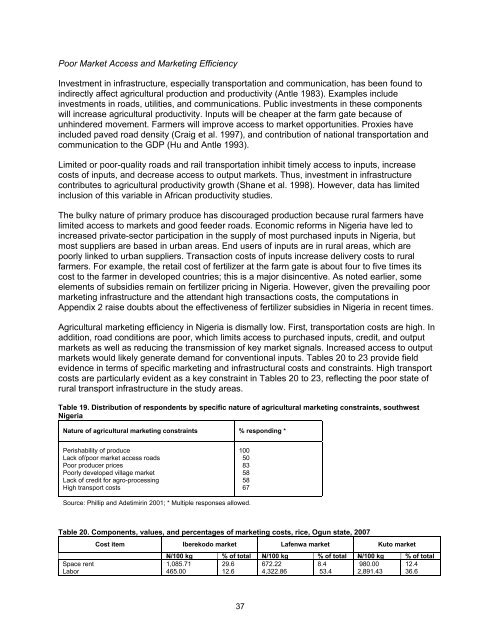Constraints to Increasing Agricultural Productivity in Nigeria: A Review
Constraints to Increasing Agricultural Productivity in Nigeria: A Review
Constraints to Increasing Agricultural Productivity in Nigeria: A Review
Create successful ePaper yourself
Turn your PDF publications into a flip-book with our unique Google optimized e-Paper software.
Poor Market Access and Market<strong>in</strong>g Efficiency<br />
Investment <strong>in</strong> <strong>in</strong>frastructure, especially transportation and communication, has been found <strong>to</strong><br />
<strong>in</strong>directly affect agricultural production and productivity (Antle 1983). Examples <strong>in</strong>clude<br />
<strong>in</strong>vestments <strong>in</strong> roads, utilities, and communications. Public <strong>in</strong>vestments <strong>in</strong> these components<br />
will <strong>in</strong>crease agricultural productivity. Inputs will be cheaper at the farm gate because of<br />
unh<strong>in</strong>dered movement. Farmers will improve access <strong>to</strong> market opportunities. Proxies have<br />
<strong>in</strong>cluded paved road density (Craig et al. 1997), and contribution of national transportation and<br />
communication <strong>to</strong> the GDP (Hu and Antle 1993).<br />
Limited or poor-quality roads and rail transportation <strong>in</strong>hibit timely access <strong>to</strong> <strong>in</strong>puts, <strong>in</strong>crease<br />
costs of <strong>in</strong>puts, and decrease access <strong>to</strong> output markets. Thus, <strong>in</strong>vestment <strong>in</strong> <strong>in</strong>frastructure<br />
contributes <strong>to</strong> agricultural productivity growth (Shane et al. 1998). However, data has limited<br />
<strong>in</strong>clusion of this variable <strong>in</strong> African productivity studies.<br />
The bulky nature of primary produce has discouraged production because rural farmers have<br />
limited access <strong>to</strong> markets and good feeder roads. Economic reforms <strong>in</strong> <strong>Nigeria</strong> have led <strong>to</strong><br />
<strong>in</strong>creased private-sec<strong>to</strong>r participation <strong>in</strong> the supply of most purchased <strong>in</strong>puts <strong>in</strong> <strong>Nigeria</strong>, but<br />
most suppliers are based <strong>in</strong> urban areas. End users of <strong>in</strong>puts are <strong>in</strong> rural areas, which are<br />
poorly l<strong>in</strong>ked <strong>to</strong> urban suppliers. Transaction costs of <strong>in</strong>puts <strong>in</strong>crease delivery costs <strong>to</strong> rural<br />
farmers. For example, the retail cost of fertilizer at the farm gate is about four <strong>to</strong> five times its<br />
cost <strong>to</strong> the farmer <strong>in</strong> developed countries; this is a major dis<strong>in</strong>centive. As noted earlier, some<br />
elements of subsidies rema<strong>in</strong> on fertilizer pric<strong>in</strong>g <strong>in</strong> <strong>Nigeria</strong>. However, given the prevail<strong>in</strong>g poor<br />
market<strong>in</strong>g <strong>in</strong>frastructure and the attendant high transactions costs, the computations <strong>in</strong><br />
Appendix 2 raise doubts about the effectiveness of fertilizer subsidies <strong>in</strong> <strong>Nigeria</strong> <strong>in</strong> recent times.<br />
<strong>Agricultural</strong> market<strong>in</strong>g efficiency <strong>in</strong> <strong>Nigeria</strong> is dismally low. First, transportation costs are high. In<br />
addition, road conditions are poor, which limits access <strong>to</strong> purchased <strong>in</strong>puts, credit, and output<br />
markets as well as reduc<strong>in</strong>g the transmission of key market signals. Increased access <strong>to</strong> output<br />
markets would likely generate demand for conventional <strong>in</strong>puts. Tables 20 <strong>to</strong> 23 provide field<br />
evidence <strong>in</strong> terms of specific market<strong>in</strong>g and <strong>in</strong>frastructural costs and constra<strong>in</strong>ts. High transport<br />
costs are particularly evident as a key constra<strong>in</strong>t <strong>in</strong> Tables 20 <strong>to</strong> 23, reflect<strong>in</strong>g the poor state of<br />
rural transport <strong>in</strong>frastructure <strong>in</strong> the study areas.<br />
Table 19. Distribution of respondents by specific nature of agricultural market<strong>in</strong>g constra<strong>in</strong>ts, southwest<br />
<strong>Nigeria</strong><br />
Nature of agricultural market<strong>in</strong>g constra<strong>in</strong>ts % respond<strong>in</strong>g *<br />
Perishability of produce<br />
Lack of/poor market access roads<br />
Poor producer prices<br />
Poorly developed village market<br />
Lack of credit for agro-process<strong>in</strong>g<br />
High transport costs<br />
100<br />
50<br />
83<br />
58<br />
58<br />
67<br />
Source: Phillip and Adetimir<strong>in</strong> 2001; * Multiple responses allowed.<br />
Table 20. Components, values, and percentages of market<strong>in</strong>g costs, rice, Ogun state, 2007<br />
Space rent<br />
Labor<br />
Cost item Iberekodo market Lafenwa market Ku<strong>to</strong> market<br />
N/100 kg % of <strong>to</strong>tal N/100 kg % of <strong>to</strong>tal N/100 kg % of <strong>to</strong>tal<br />
1,085.71<br />
465.00<br />
29.6<br />
12.6<br />
37<br />
672.22<br />
4,322.86<br />
8.4<br />
53.4<br />
980.00<br />
2,891.43<br />
12.4<br />
36.6
















